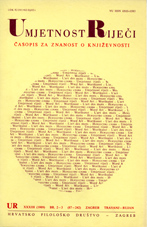Teorija semiotike Umberta Eca
Umberto Eco's Theory of Semiotics
Author(s): Miroslav Beker Subject(s): Semiotics / Semiology
Published by: Hrvatsko filološko društvo
Summary/Abstract: The primary aim of the paper is to present an outline of Umberto Eco's Theory of Semiotics as an important contribution to contemporary semiotic studies. The author mentions Eco's favourite example of the watergate and the signalling system, illustrating the idea of coding, of denotation and connotation. He also discusses compositional analysis (including Eco's criticism of the Katz and Fodor model) as well as the notions of overcoding, undercoding and extracoding. After the theory of codes he deals with Eco's discussion of sign production, the types of effort required to produce signs and their modalities (recognition, ostension, replica, and invention). He also draws attention to Eco's distinction between the handling of codes in ideological and aesthetic procedures. In order to illustrate Eco's theory he uses numerous examples and compares semiotic theory with the »practice« in The Name of the Rose. In the end he expresses the view that in his semiotic theory Eco's way of reasoning tends to be within the poststructuralist framework of modern thought.
Journal: Umjetnost riječi
- Issue Year: 1989
- Issue No: 2-3
- Page Range: 93-114
- Page Count: 22
- Language: Croatian
- Content File-PDF

